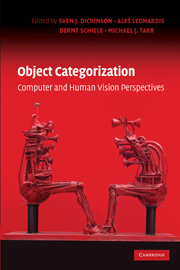Book contents
- Frontmatter
- Contents
- Preface
- Contributors
- 1 The Evolution of Object Categorization and the Challenge of Image Abstraction
- 2 A Strategy for Understanding How the Brain Accomplishes Object Recognition
- 3 Visual Recognition Circa 2008
- 4 On What It Means to See, and WhatWe Can Do About It
- 5 Generic Object Recognition by Inference of 3-D Volumetric Parts
- 6 What Has fMRI Taught Us About Object Recognition?
- 7 Object Recognition Through Reasoning About Functionality: A Survey of Related Work
- 8 The Interface Theory of Perception: Natural Selection Drives True Perception to Swift Extinction
- 9 Words and Pictures: Categories, Modifiers, Depiction, and Iconography
- 10 Structural Representation of Object Shape in the Brain
- 11 Learning Hierarchical Compositional Representations of Object Structure
- 12 Object Categorization in Man, Monkey, and Machine: Some Answers and Some Open Questions
- 13 Learning Compositional Models for Object Categories from Small Sample Sets
- 14 The Neurophysiology and Computational Mechanisms of Object Representation
- 15 From Classification to Full Object Interpretation
- 16 Visual Object Discovery
- 17 Towards Integration of Different Paradigms in Modeling, Representation, and Learning of Visual Categories
- 18 Acquisition and Disruption of Category Specificity in the Ventral Visual Stream: The Case of Late Developing and Vulnerable Face-Related Cortex
- 19 Using Simple Features and Relations
- 20 The Proactive Brain: Using Memory-Based Predictions in Visual Recognition
- 21 Spatial Pyramid Matching
- 22 Visual Learning for Optimal Decisions in the Human Brain
- 23 Shapes and Shock Graphs: From Segmented Shapes to Shapes Embedded in Images
- 24 Neural Encoding of Scene Statistics for Surface and Object Inference
- 25 Medial Models for Vision
- 26 Multimodal Categorization
- 27 Comparing 2-D Images of 3-D Objects
- Index
- Plate section
21 - Spatial Pyramid Matching
Published online by Cambridge University Press: 20 May 2010
- Frontmatter
- Contents
- Preface
- Contributors
- 1 The Evolution of Object Categorization and the Challenge of Image Abstraction
- 2 A Strategy for Understanding How the Brain Accomplishes Object Recognition
- 3 Visual Recognition Circa 2008
- 4 On What It Means to See, and WhatWe Can Do About It
- 5 Generic Object Recognition by Inference of 3-D Volumetric Parts
- 6 What Has fMRI Taught Us About Object Recognition?
- 7 Object Recognition Through Reasoning About Functionality: A Survey of Related Work
- 8 The Interface Theory of Perception: Natural Selection Drives True Perception to Swift Extinction
- 9 Words and Pictures: Categories, Modifiers, Depiction, and Iconography
- 10 Structural Representation of Object Shape in the Brain
- 11 Learning Hierarchical Compositional Representations of Object Structure
- 12 Object Categorization in Man, Monkey, and Machine: Some Answers and Some Open Questions
- 13 Learning Compositional Models for Object Categories from Small Sample Sets
- 14 The Neurophysiology and Computational Mechanisms of Object Representation
- 15 From Classification to Full Object Interpretation
- 16 Visual Object Discovery
- 17 Towards Integration of Different Paradigms in Modeling, Representation, and Learning of Visual Categories
- 18 Acquisition and Disruption of Category Specificity in the Ventral Visual Stream: The Case of Late Developing and Vulnerable Face-Related Cortex
- 19 Using Simple Features and Relations
- 20 The Proactive Brain: Using Memory-Based Predictions in Visual Recognition
- 21 Spatial Pyramid Matching
- 22 Visual Learning for Optimal Decisions in the Human Brain
- 23 Shapes and Shock Graphs: From Segmented Shapes to Shapes Embedded in Images
- 24 Neural Encoding of Scene Statistics for Surface and Object Inference
- 25 Medial Models for Vision
- 26 Multimodal Categorization
- 27 Comparing 2-D Images of 3-D Objects
- Index
- Plate section
Summary
Introduction
This chapter deals with the problem of whole-image categorization. We may want to classify a photograph based on a high-level semantic attribute (e.g., indoor or outdoor), scene type (forest, street, office, etc.), or object category (car, face, etc.). Our philosophy is that such global image tasks can be approached in a holistic fashion: It should be possible to develop image representations that use low-level features to directly infer high-level semantic information about the scene without going through the intermediate step of segmenting the image into more “basic” semantic entities. For example, we should be able to recognize that an image contains a beach scene without first segmenting and identifying its separate components, such as sand, water, sky, or bathers. This philosophy is inspired by psychophysical and psychological evidence that people can recognize scenes by considering them in a “holistic” manner, while overlooking most of the details of the constituent objects (Oliva and Torralba 2001). It has been shown that human subjects can perform high-level categorization tasks extremely rapidly and in the near absence of attention (Thorpe et al. 1996; Fei-Fei et al. 2002), which would most likely preclude any feedback or detailed analysis of individual parts of the scene.
Renninger and Malik (2004) have proposed an orderless texture histogram model to replicate human performance on “pre-attentive” classification tasks. In the computer vision literature, more advanced orderless methods based on bags of features (Csurka et al. 2004) have recently demonstrated impressive levels of performance for image classification.
Information
- Type
- Chapter
- Information
- Object CategorizationComputer and Human Vision Perspectives, pp. 401 - 415Publisher: Cambridge University PressPrint publication year: 2009
Accessibility standard: Unknown
Why this information is here
This section outlines the accessibility features of this content - including support for screen readers, full keyboard navigation and high-contrast display options. This may not be relevant for you.Accessibility Information
- 35
- Cited by
